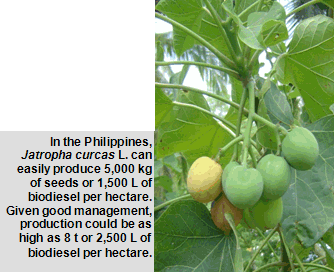The Philippine government gives high priority on Jatropha curcas as feedstock for biodiesel as compared to other locally produced biodiesel sources. Jatropha curcas, locally known as ‘tubang bakod’, was found to exhibit more potential as an alternative to high-valued products. Hence, a subprogram under the National Biofuels (research and development) R&D Program on Jatropha for biodiesel production was initiated by PCARRD.

The Philippine government gives high priority on Jatropha curcas as feedstock for biodiesel as compared to other locally produced biodiesel sources. Jatropha curcas, locally known as ‘tubang bakod’, was found to exhibit more potential as an alternative to high-valued products. Hence, a subprogram under the National Biofuels (research and development) R&D Program on Jatropha for biodiesel production was initiated by PCARRD.
The subprogram on jatropha, which focused on the agriculture component of feedstock production, has project components namely (1) Germplasm management, varietal improvement and seed technology; (2) Development of component technologies for Jatropha in various production systems; (3) Development of farming systems models integrating Jatropha curcas in various production systems; (4) Development of postproduction machinery for Jatropha curcas; and (5) Process and equipment development for the production of esterified Jatropha curcas oil. With full financial support from the Department of Science and Technology (DOST) and the Philippine National Oil Company-Alternative Fuels Corporation (PNOC-AFC), the subprogram started its implementation in July 2007.
The University of the Philippines Los Baños, DOST, PNOC-AFC, and PCARRD Research, Development, and Extension Team hopes to deliver the culture and management of jatropha as feedstock for biodiesel production under Philippine setting within the next three years. The R&D-based integrated jatropha program is envisioned to provide a package of appropriate field-tested production and management technology that considers the Philippine environmental and social milieu to support and sustain an emerging biofuels industry in the country.
At present, R&D data are still being generated, thus the viability of Jatropha production under local conditions cannot be compared. However, as a tropical country, researchers are confident that yield per hectare (under same level of management) will be higher than the countries from South Asia. Likewise, the viability of existing commercial plantations linked with smallhold farms will be assessed and improved for viable feedstock production. Moreover, appropriate pest and disease management schemes must be ensured in the likelihood of pest & disease incidence as an offshoot of massive plantation development.
To date, 25 jatropha genotypes, from the germplasm collection nationwide, were initially selected and established at the UPLB Central Experiment Station for varietal improvement activities. Earlier in 2006, the Commission on Higher Education has already tapped 17 state colleges and universities to engage in nursery and plantation development of Jatropha curcas. The activity aimed to produce good quality planting materials and maintain a collection of local germplasm in the plantation. While there were so many reported plantation developments undertaken by the private sectors, still the science-based information and technologies need to be completed and firmed up before jatropha can safely be recommended for massive domestication preferably in areas where food crops are not cultivated.
